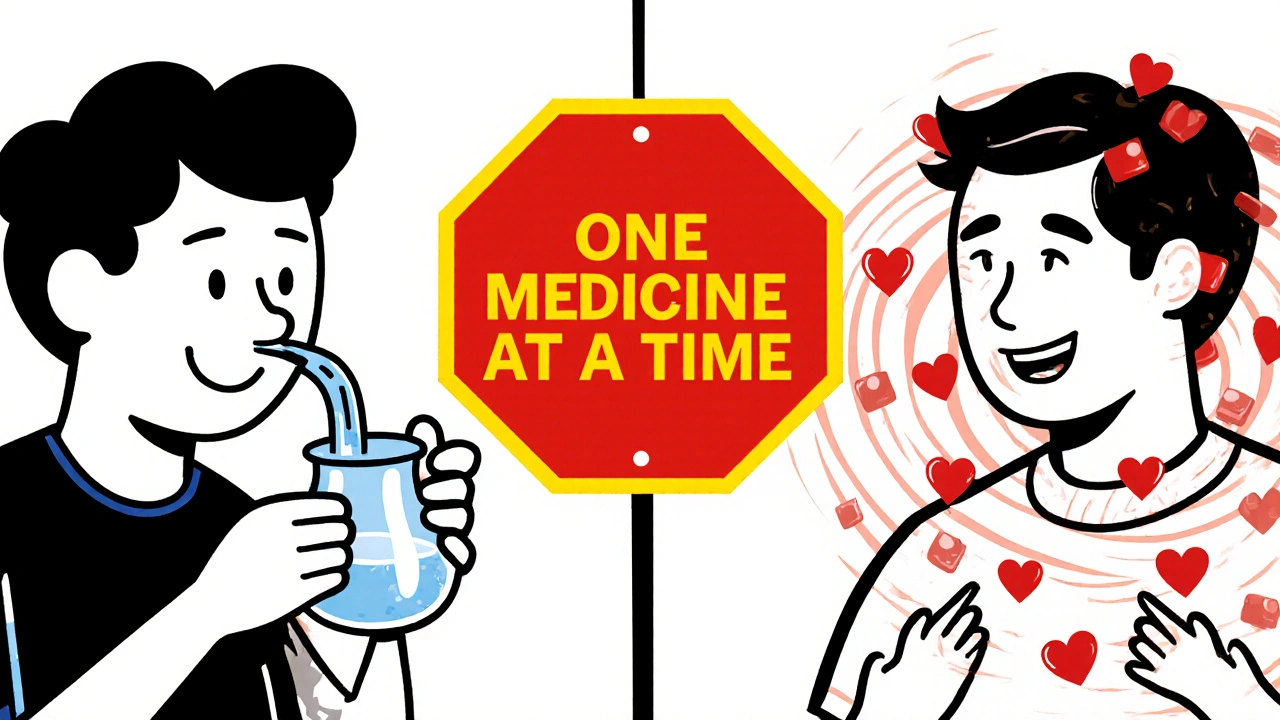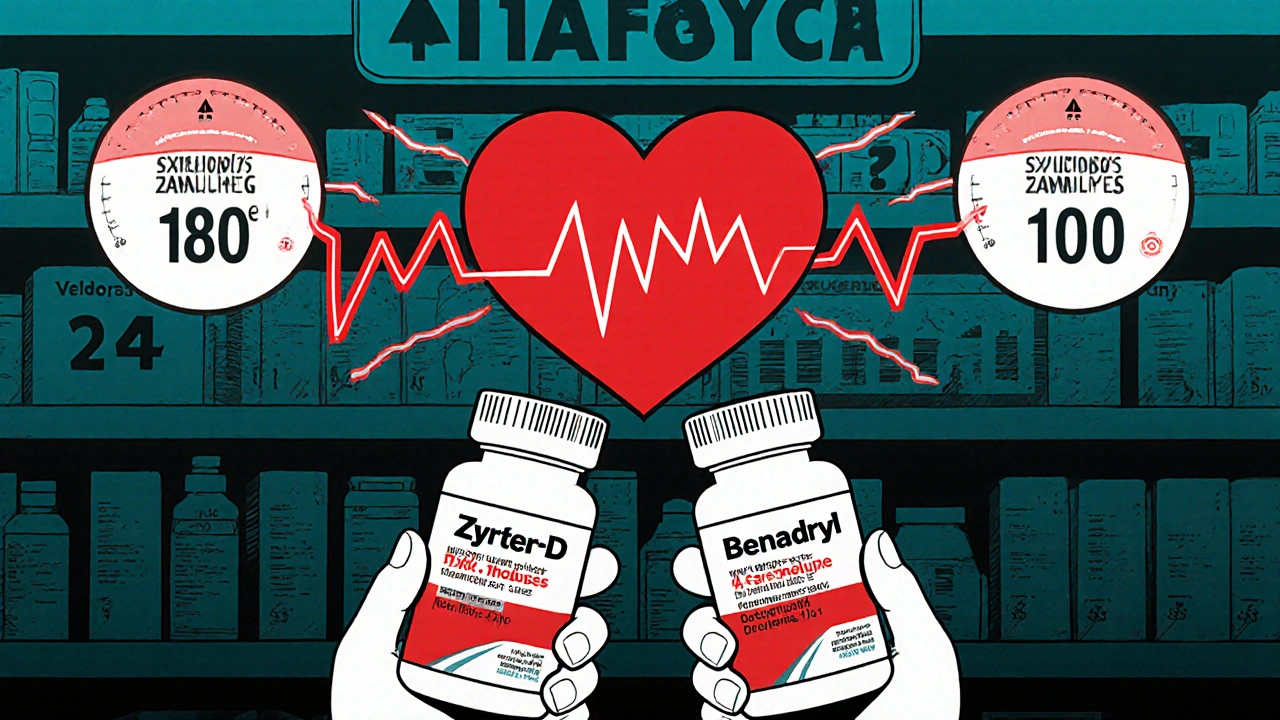Decongestant-Antihistamine Safety Calculator
Check Your Risk
Enter your health information to see if combining decongestants and antihistamines is safe for you.
Enter your information to see your risk level
Many people reach for combination cold and allergy meds like Zyrtec-D or Claritin-D because they promise quick relief from runny nose, congestion, and sneezing-all in one pill. But behind the convenience lies a hidden risk: these combinations can be dangerous if you don’t know how they work-or what they’re doing to your body.
How These Medications Actually Work
Decongestants like pseudoephedrine and phenylephrine shrink swollen blood vessels in your nose to clear congestion. Antihistamines like cetirizine, loratadine, or diphenhydramine block histamine, the chemical your body releases during allergies, which causes sneezing, itching, and watery eyes. Together, they tackle multiple symptoms at once. That sounds smart-until you realize how much strain this puts on your system.
First-generation antihistamines like diphenhydramine (found in Benadryl) make about half of users drowsy. Even second-generation ones like cetirizine (Zyrtec) cause noticeable sleepiness in 14% of people. Meanwhile, decongestants raise blood pressure-on average, 1-2 mmHg in healthy adults, but up to 10 mmHg in people with existing hypertension. That’s not a small bump. It’s enough to trigger chest pain, dizziness, or even a stroke in vulnerable individuals.
The Hidden Danger: Overlapping Ingredients
One of the biggest mistakes people make is taking more than one antihistamine at a time. Maybe you took Zyrtec in the morning, then added Benadryl at night because your symptoms didn’t go away. That’s a problem. Both are antihistamines. You’re doubling down on side effects: extreme drowsiness, dry mouth, blurred vision, confusion, and trouble urinating. In older adults, this can lead to falls or even delirium.
Poison Control explicitly warns: Do NOT take two different antihistamines at the same time. And it’s not just about antihistamines. If you’re already taking a decongestant in your allergy med, then grab a cold tablet with phenylephrine or pseudoephedrine on top of it, you’re stacking stimulants. That can cause your heart to race, your blood pressure to spike, and your nerves to feel like they’re on fire.
GoodRx reports that mixing Zyrtec and Benadryl, Claritin and Benadryl, or Allegra and Zyrtec is common-and dangerous. Zyrtec lasts up to 24 hours. Benadryl wears off in 4-6. Taking them together doesn’t mean better relief. It means your body is drowning in medication.
Who’s at the Highest Risk?
If you have high blood pressure, heart disease, diabetes, or an overactive thyroid, these combinations aren’t just risky-they’re potentially life-threatening. Decongestants act like adrenaline. They make your heart beat faster and your blood vessels tighter. For someone with angina or arrhythmia, that’s like pouring gasoline on a smoldering fire.
Older adults are especially vulnerable. Their bodies process drugs slower. Even normal doses can build up and cause confusion, urinary retention, or dangerously low blood pressure after the initial spike. The American Academy of Family Physicians says there’s no proven benefit for children under 12-and plenty of documented harm. Yet parents still give these meds to kids because they’re “just over-the-counter.”

What the Evidence Really Says
A 2022 Cochrane review analyzed dozens of studies and found that while these combinations might offer slight relief for adults, the effect on individual symptoms is too small to be meaningful. The benefits? Barely noticeable. The side effects? Very real. In one study, 31% of people taking antihistamine-decongestant combos reported adverse reactions-compared to just 13% in placebo groups.
And it’s not just about feeling sleepy or having a dry mouth. Serious reactions include rapid or irregular heartbeat, swelling of the face or throat, seizures, and in rare cases, cardiac arrest. The FDA received over 1,800 adverse event reports for these combinations in 2022 alone.
Why These Products Are Still on the Shelf
Despite the risks, these drugs are everywhere. Why? Because they sell. In 2022, the U.S. over-the-counter allergy market was worth $2.8 billion. About 35% of those sales came from combination products. Four out of ten Americans who buy allergy meds pick a decongestant-antihistamine mix. Companies market them as “24-hour relief” or “all-in-one,” making them feel like a no-brainer.
But here’s the catch: many of these products contain pseudoephedrine, which is kept behind the pharmacy counter because it can be used to make illegal drugs. That doesn’t make them safer-it just makes them harder to get. Phenylephrine, the alternative found in many “Sudafed PE” products, is now widely considered ineffective at relieving congestion, according to the FDA. So you’re paying for a pill that doesn’t work well-and still carries all the risks.

What You Should Do Instead
Stop reaching for the combo pack. Instead, treat symptoms one at a time.
- If you have congestion, use a nasal spray like oxymetazoline (Afrin) for no more than three days-or try a saline rinse.
- If you have sneezing or itchy eyes, take a single antihistamine like loratadine (Claritin) or fexofenadine (Allegra)-and avoid taking it with anything else that contains an antihistamine.
- If you have pain or fever, use acetaminophen or ibuprofen separately.
This approach gives you control. You know exactly what you’re taking. You can adjust doses. You can avoid dangerous overlaps. And you reduce your risk of side effects dramatically.
When to Talk to a Doctor
If you’re regularly using these combination meds-especially if you’re over 60, have heart problems, or take other prescriptions-you need to talk to a healthcare provider. Many people don’t realize that antihistamines can interfere with antidepressants, blood pressure meds, and even thyroid drugs. A pharmacist can check for interactions in seconds.
Also, if you’ve ever felt your heart racing after taking one of these pills, or if you’ve had trouble sleeping, felt unusually anxious, or noticed swelling, stop taking it. Document what happened. Bring it to your doctor. These aren’t “just side effects.” They’re warning signs.
The Bottom Line
Decongestants with antihistamines aren’t harmless. They’re powerful drugs disguised as simple remedies. The convenience comes at a cost: higher blood pressure, drowsiness, heart strain, and a real chance of overdose if you mix them with other meds. You don’t need a combo pill to feel better. You need to understand your body-and your meds.
Read the labels. Know what’s in each pill. Don’t assume “OTC” means “safe.” And if you’re unsure-ask. A pharmacist is just as qualified as a doctor to answer your questions about these medicines. Sometimes, the safest choice isn’t the one with the most features. It’s the one with the fewest risks.





Meghan Rose
I took Zyrtec-D last week and thought I was having a stroke. Heart racing, hands shaking, couldn't sleep for 36 hours. Now I only use plain Claritin. No more combo pills for me.
Steve Phillips
Oh, so you're telling me that Big Pharma's $2.8 billion marketing machine is just... lying to us? Shocking. I mean, who could've guessed that a pill with '24-HOUR RELIEF!' on it might be a chemical dumpster fire? 🤡 The FDA gets 1,800 reports-and still, we're expected to trust the label? Please. I'd rather swallow a wasp than another 'OTC miracle'.
Rachel Puno
This is so important. I used to stack meds like snacks until my mom had a fall because she was too drowsy. Now I keep a little notebook: what I took, when, and how I felt. Simple. No fancy apps. Just pen and paper. Your body will thank you. Start small. One med at a time. You got this.
Clyde Verdin Jr
YOOOOO I JUST TOOK ZYRTEC-D AND NOW I’M A ROBOT WITH A HEART ATTACK 😵💫💥 My eyes felt like they were glued shut and my chest felt like it was being squeezed by a python. I’m not even allergic. I just wanted to ‘feel better.’ Now I’m crying in the shower. Someone send help. Or at least a lawyer.
Key Davis
It is imperative to recognize that the over-the-counter designation does not equate to safety. The pharmacological burden imposed by concomitant administration of antihistamines and decongestants is both clinically significant and underappreciated. I urge all patients to consult with a licensed pharmacist prior to polypharmacy. The risk-benefit ratio is profoundly unfavorable.
Cris Ceceris
I wonder if we’ve just normalized danger because it’s convenient. We take these pills like they’re coffee. But they’re not. They’re tiny chemical levers that shift your whole nervous system. What does it say about us that we’d rather numb our symptoms than figure out why they’re there? Maybe the real problem isn’t the medicine… it’s how we live.
Brad Seymour
Love this breakdown. I’m from the UK and we’ve got the same junk on shelves here. My mate took Claritin-D and ended up in A&E with palpitations. He thought it was ‘just a cold.’ Same story every time. Honestly, if you’re gonna take two meds, just go see a doc. It’s cheaper in the long run.
Malia Blom
So let me get this straight. The FDA says these drugs are dangerous, the science says they barely work, and yet we keep buying them because the label says ‘ALL-IN-ONE’? That’s not medicine. That’s a cult. We’ve been conditioned to believe that more = better. But in pharmacology, more just means more things going wrong. We’re not patients. We’re consumers. And they’re selling us poison with a rainbow sticker.
Abigail Chrisma
My grandma used to say, ‘If it’s not helping, it’s hurting.’ She never took anything but saline spray and honey. She’s 89 and still walks three miles a day. I started doing the same. No more combo pills. No more confusion. Just one thing at a time. And guess what? I feel clearer. Not just my nose-my brain too.
Ankit Yadav
I’m from India and we don’t have these combo pills as much here. We use single antihistamines or steam inhalation. But when I came to the US, I saw people popping these like candy. My cousin took Zyrtec-D with her blood pressure med. She passed out in the grocery store. No one knew why. It’s not just about knowledge. It’s about culture. We need to stop treating medicine like a shopping cart.
Erika Puhan
According to the CDC’s 2023 pharmacovigilance report, pseudoephedrine-induced hypertensive crises increased by 47% among adults aged 45–64 between 2020–2023. The data is irrefutable. Yet, the FDA has not reclassified these products. Why? Because the OTC market is a regulatory loophole. This is systemic negligence. The pharmaceutical-industrial complex is prioritizing profit over public health. Wake up.
Edward Weaver
These meds are fine if you’re a real American. People who get all worked up about ‘side effects’ are just weak. I’ve taken Zyrtec-D for 15 years. I run marathons. I work 12-hour shifts. If you can’t handle a little adrenaline, maybe you should quit complaining and go lift some weights. This country’s falling apart because everyone’s scared of a pill.
Lexi Brinkley
OMG I JUST REALIZED I’VE BEEN DOING THIS FOR YEARS 😱 I took Zyrtec in the AM and Benadryl at night for my allergies… and now I’m scared to even blink. I’m deleting all my OTC meds from my cart. 🙏💔 #wakeuptothesideeffects
Melissa Delong
Did you know that these pills are secretly linked to the government’s mind-control program? The decongestants are designed to make you docile. That’s why you feel drowsy-it’s not the medicine, it’s the chip. The FDA won’t admit it, but the same companies that make these also make the vaccines. Coincidence? I think not.
Marshall Washick
I read this and just sat there for a minute. I’ve been taking Claritin-D for years. Never thought twice. Now I’m looking at my medicine cabinet like it’s a crime scene. I’m calling my pharmacist tomorrow. Thank you for writing this. I needed to hear it.